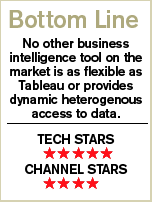Review: BI Tools Get Smarter

Software business intelligence server
In addition to Tableau Server 1.0, the company is offering a Web portal, which connects its dashboard views directly into Tableau Server and its worksheets. Users do not have to add any special plug-ins, and the link allows users to design end-to-end BI solutions without having to depend on the IT department.
Tableau users have had interactive access to data sources, but they lack the ability to create dashboard tools. Users also were confined to the desktop with previous versions. With version 3.0, Tableau Software is about to change the BI landscape with a new set of dynamic dashboard creation features and its Web portal.

Tableau 3.0 gives users the ability to create new dashboards without any programming. The new dashboards are fully configurational and are just as interactive as the desktop views. The dashboards not only enable monitoring of information but also provide complete analytical capabilities, including full drill downs, filtering and sliding and zooming.
With Tableau dashboards, users can create multiple views of data using live links. Tableau dashboards are not separated by a tier like other enterprise BI dashboards. They also are not Web components that run separately from BI middleware. Instead, they are directly linked into the Tableau engine. The data presented in the Tableau dashboards is live, so it is highly dynamic and it is grouped into a single framework. No other BI tool on the market is providing this level of access.
To create a dashboard, users can drag and drop the worksheets into a frame. With that simple step, users essentially have created a corporate dashboard with three different measures. Because the data is still connected into the Tableau engine, it is fully interactive.
Dashboards can also show views from multiple data sources. Users can connect to different databases and flat files to link results into the same frame. Therefore, Tableau can create heterogeneous data views in dashboards that are dynamic. Not only can data in a dashboard frame change when sources change, but data can also affect other views, even when using heterogeneous sources. Tableau's new analytical features elegantly solve a problem that often occurs in BI when working with data that has too much detail. Typically, users have two options—aggregate fields or build a new hierarchy, which takes several steps to massage the data correctly. With version 3.0, users can create ad hoc groups that combine fields into single dimensions. Tableau treats the combined fields as a new group.
Another new feature is one-click sorting, available on the dashboard, which allows users to sort on many measures at once after accessing and selecting a pane. Users are able to compare many different measures quickly.
Tableau is popular in the open source community because it works with MySQL, PostgreSQL and Firefox. The open source BI market is limited to some primitive enterprise tools and there is nothing that desktop users can use. Tableau is also compatible with Excel, Access, SQL SSAS, and IBM DB2.